The treatments for mental illness have changed and adjusted over the past century. The Traverse City State Hospital spanned this timeframe. It was a perfect hospital to conduct research. Experimentation was evident as medical regimens were developed. I have held a lot of curiosity about navigating these remedies as our oldest child was subjected to medications for debilitating epilepsy.
Our daughter, Charlotte, had a traumatic birth and needed to be resuscitated. Through elementary school she was learning and growing well until June of her eleventh year. Charlotte started having six to eight seizures daily. Our sweet girl couldn’t recall what day it was or how to care for herself. She’d gone from being full of ideas with a sense of humor to being pan faced and staring aimlessly. She had been involved in theater, easily memorizing lines and acting dramatically to suddenly she was staring, rocking and asking, “What day is it?”
We met with neurologists and had EEG tests done. These tests measure brain activity and could pin point the location of her seizures. At the beginning of adolescence the brain starts to make ‘short cuts’ and fires through new parts of the brain. Charlotte’s seizures were centered at her hypothalamus. It is the center of the brain and controls a wide variety of functions. With the loss of this regulatory system, she had become severely impaired.
Dr. Chadehumbe tried different medications. We spent time weening her off one pill to start another prescription. We charted her seizures and made graphs. I suppose we wanted some sort of control over this situation where we were feeling helpless. As we prepared to start yet another medication, Dr. Chadehumbe said, “It this one doesn’t work, we will need to do surgery and take out the unhappy part of Charlotte’s brain.” Just typing this statement still knocks the wind out of me.
Miracles do happen! On October 3, 2009 Charlotte came out of the restroom, showered and dressed, informing me that we need more shampoo. She had been seizure free for one day and her short term memory was already returning, as well as her self care! Prayers of thankfulness were lifted right then and there! We worked with a neuropsych doctor to rebuild her memory and learning skills.
Charlotte graduated from Lowell High School and pursued coursework in the medical field. In four years she earned her Clinical Laboratory Scientist degree from Michigan State University. Charlotte currently lives in Ypsilaniti and works at St. Joe Hospital in Ann Arbor. She’s my hero! My prayers of thankfulness continue to be lifted every day!
As we toured the Traverse City State Hospital last October, I knew I wanted to write about the evolution of treatments for mental illness. Although some methods were questionable, I am incredibly indebted to those who developed treatments that brought our daughter back from the darkest place I had ever seen.
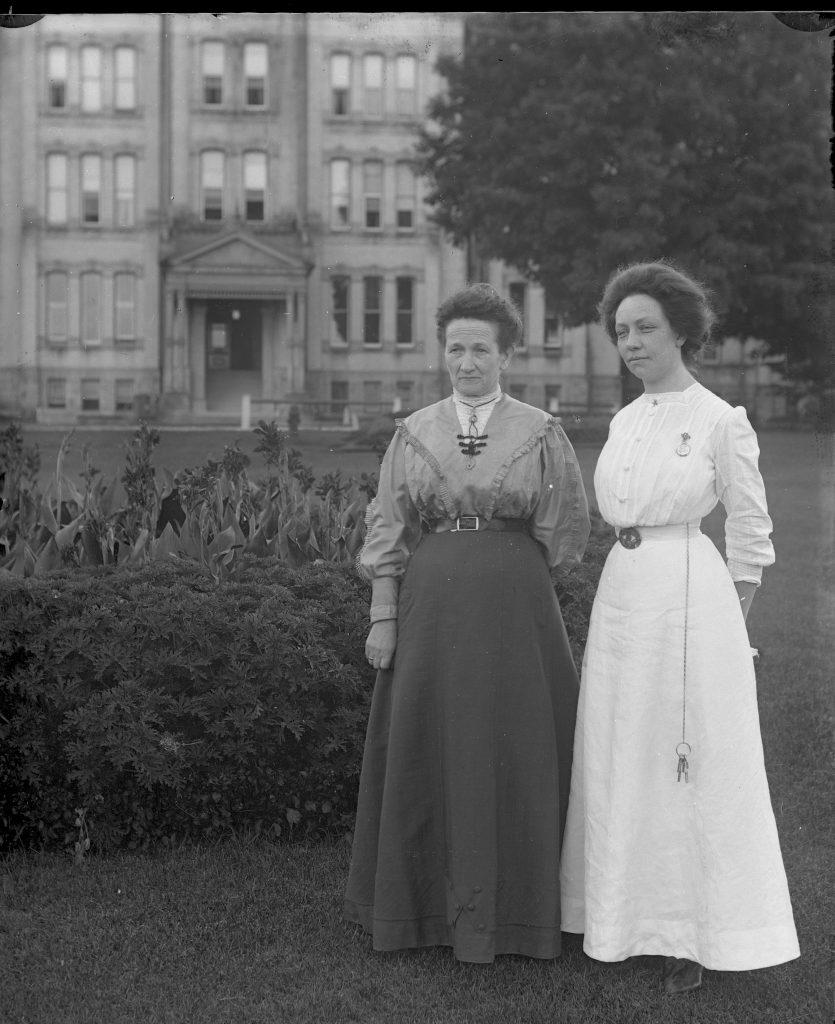
This photo (Courtesy of the Traverse City Historical Society) was taken between 1898-1912.
“Beauty is Therapy” was the premise of the Traverse City State Asylum when it opened in 1885. It was designed by George W. Lloyd following the Kirkbride model. Patients were permitted to walk among the majestic buildings enjoying the beautifully manicured grounds. Most ‘residents’ worked on campus creating a self sustaining community. There was a working farm with dairy cows, pigs and chickens. The five greenhouses grew sprouting vegetables as well as flowers. The grounds needed tending. The massive amount of laundry as well as the cooking that needed to be done to maintain around 3,000 patients required many hands.
Peggy Wagner had started working at Hall 5 in 1947 at just 19 years old. She recalled having “peeling parties” where the residents were eager to help prepare vegetables. They would be rewarded with a cookie.
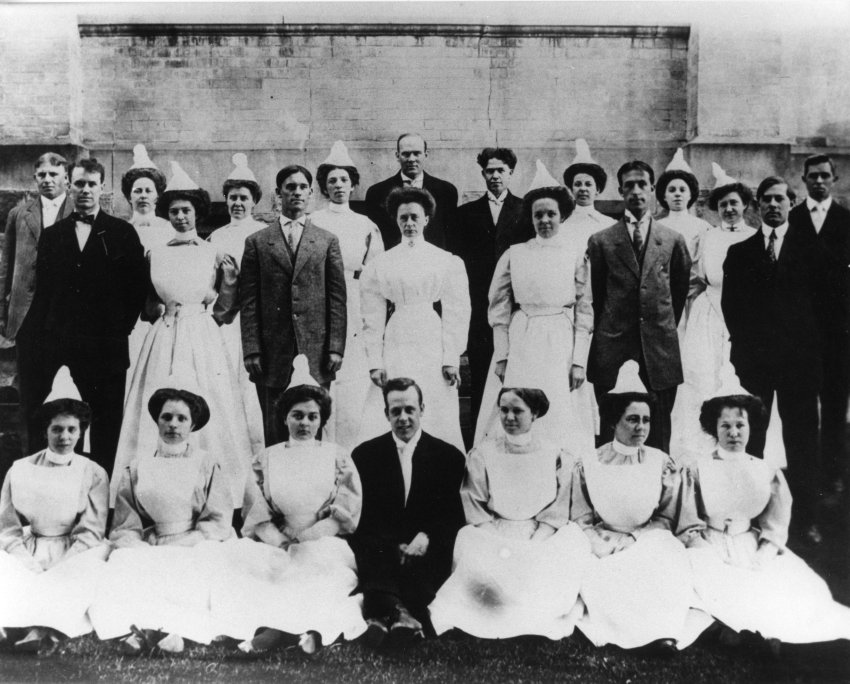
Photo courtesy of the Traverse City Historical Society 1898-1912
Patients and staff ate their meals together in a common dining hall. The tables were adored with fresh flowers and table linens. Horrace G. Storrs shared that many staff members lived in dormitories for employees.
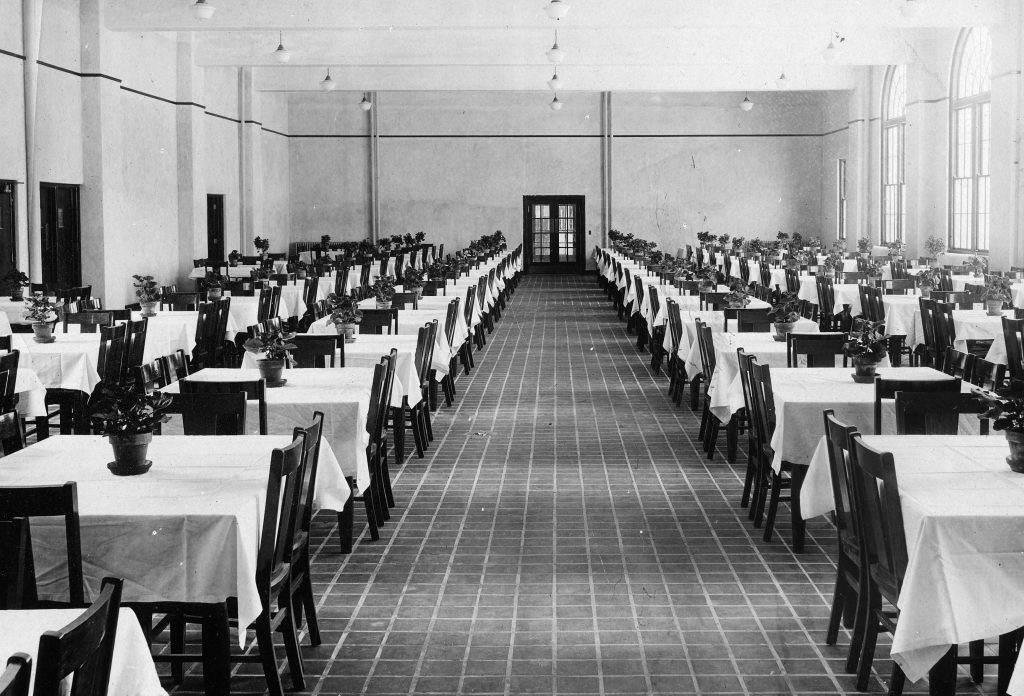
The flowers were grown in one of the greenhouses on the property.
The hospital had a library and a theater for plays, sing a-longs and church. There was a football and baseball team that would oppose local high schools.
In 1908 the cost of care was $0.42 each day in the lower peninsula and $0.50 per day in the upper peninsula. On July 29 a meeting was held in Lansing with the goal of reducing costs. The Michigan asylum superintendents from both peninsulas joined with their advisors and lawmakers as well as Bishop George Dietple from Grand Rapids. Cutback were being introduced to the hospitals.
In the 1930’s the depression struck America. Alcoholism and depression were cause for institutionalization. The hospital was crowded and funding was decreasing. For example, one Catholic woman was committed by her husband. They had many children and he was out of work. With such a large family her husband sold their infant daughter. His wife he claimed “was no help a’toll,” when he dropped her off.
It was 1933 when the United States started using insulin to induce coma with patients suffering from manic episodes. High doses of insulin would be injected in schizophrenic patients to bring about “mental clarity.” It was the only known remedy for this mental condition. Later, in the 1950’s this treatment was discredited.
In 1935 Egas Moniz invented a new procedure disconnecting the nerve fibers between the thalamus and the frontal lobe of the brain. After practicing on chimps by boring a hole in each side of the head by the temple and using a special knife he’d separate the ‘mysterious spot’ in the middle of the brain. The leukotome was complete. This procedure was later named ‘lobotomy.’ In Lisbon, Portugal in 1936 Egas Moniz completed his first human trial on twenty patients. It was reported that “seven recovered their sanity, seven others were improved and none of them died.”
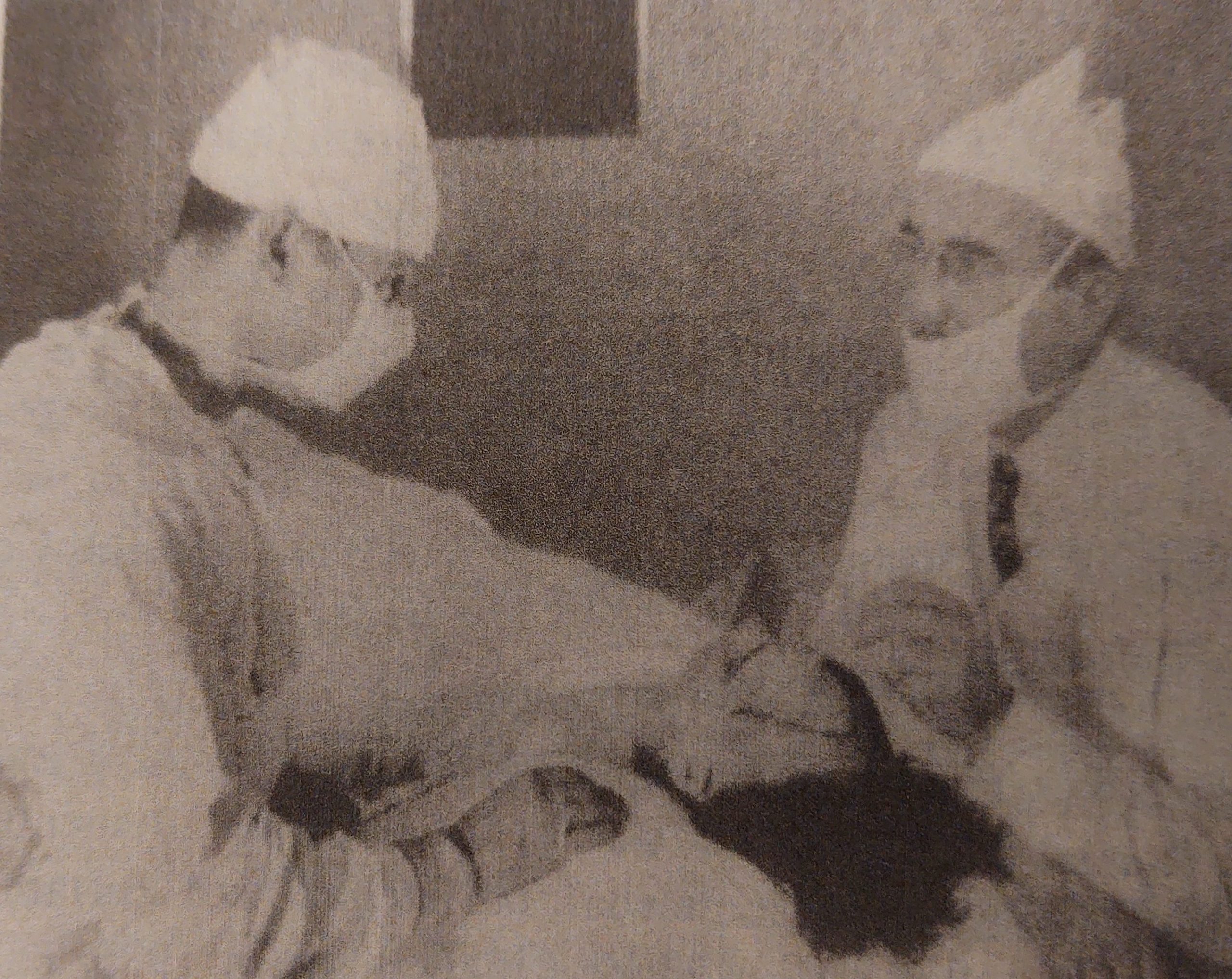
Photo Credit: “The Man Against Insanity”
Walter Freeman and James Watts continued the study with follow up exams and interviews of these twenty individuals. ‘Ten years later there were fourteen survivors. Only two were committed in mental facilities. Four were employed, four were keeping house and four were living at home with relatives.’
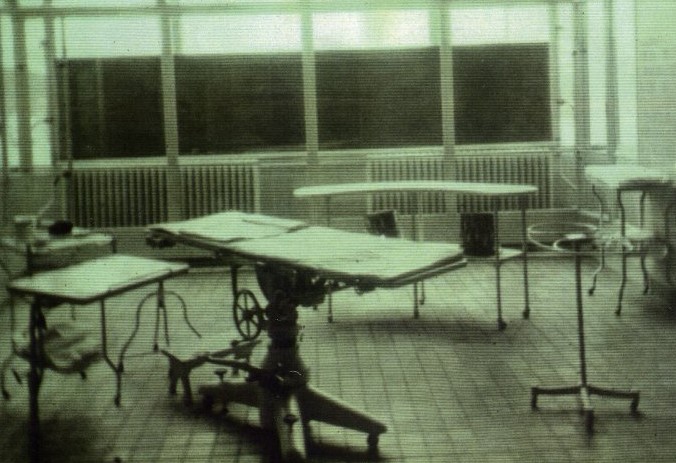
Photo Courtesy of “Traverse City State Hospital”
In 1941 Rosemary Kennedy, John F. Kennedy’s sister, underwent a lobotomy at 23 years old. At birth she had been “held in the birth canal” until the doctor could come. On September 13th, 1918 the doctor had been delayed because of patients suffering from the Spanish Flu. This two hour episode caused infant Rosemary a lack of oxygen which resulted in her diminished mental capabilities.
As a young adult Rose (Rosemary) found a job and was successful as a teacher’s aid at Belmont Montessori School. However, Joe Sr. and Rose Kennedy, her parents, spoke with Dr. Freeman. They found their daughter’s slow processing mental state was a hinderance for their family name, Kennedy. They approved the lobotomy procedure.
Dr. Freeman had Rose “recite poems as they cut. When she was silent, they knew the procedure was complete.” Sadly, after surgery it took months of therapy in a facility for Rose to regain her ability to walk and talk. Her speech was garbled and she had a stiff leg and arm for the rest of her life. She was confined to Craig House and later Saint Coletta’s residential facility until she passed away in 2005.
In 1949 Egas Moniz, creator of the lobotomy, earned the Nobel Prize for his successful treatment for the mentally ill. Following a lobotomy 75% of the individuals could live at home with relatives and not burden the resources of mental asylums. That was considered a success.
A long time staff member, Robert Maddox, reported that patients who had undergone a lobotomy had dents in their foreheads.
Electroshock therapy was another treatment used during this time and into the 1960’s. It was “emotional as hell,” reported one patient. Electrodes would be placed on the person’s temples. A bite plate would be inserted in the mouth to prevent biting one’s tongue. The current would be turned on and then off, leaving the patient writhing and convulsing for several minutes. The procedure would be repeated several times during one session.
Hydrotherapy was used in the mid 1960’s according to Bob Hall an LPN who worked in Traverse City Hospital. He explained that the patient would be placed in a tub of water with one’s head above a canvas cover secured around the tub with straps.
“Work is Therapy” philosophy ended in the 1950’s when the farm was closed. The animals were sold. The planting and harvesting ceased. Many residents just sat and stared as they had lost their purposeful work.
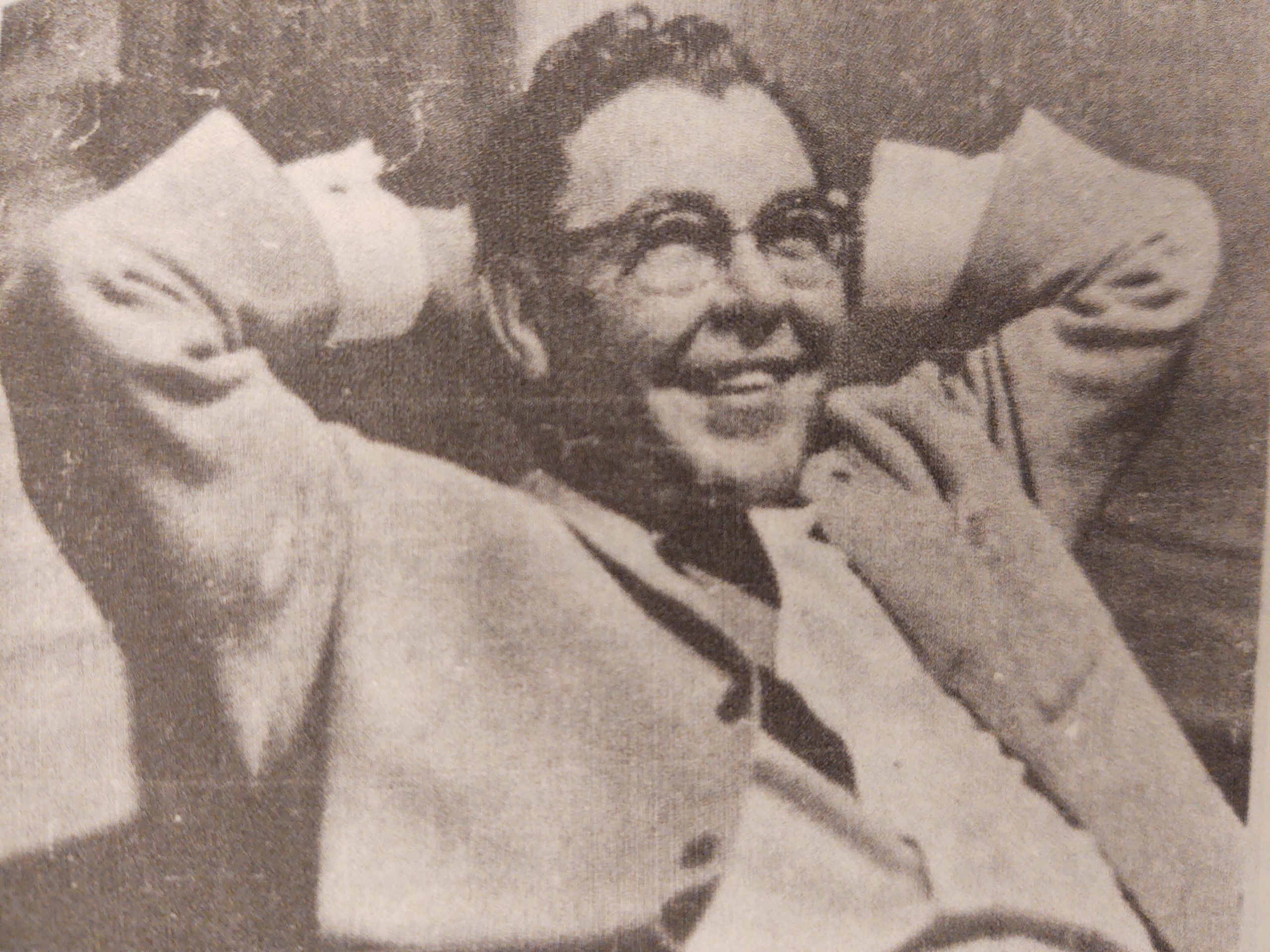
Photo Courtesy of “The Man Against Insanity”
Dr. Jack Ferguson had modified the lobotomy by using a long, narrow implement and piercing the nerve fibers of the brain by going through the eye socket. This ‘transorbital lobotomy’ could be done in five minutes or less. By 1954 he had done over 400 lobotomies at Logansport State Hospital. In the last 162 lobotomies performed, Ferguson ‘reported they had not had a single death.’
Dr. Ferguson was hired by Traverse City State Hospital in 1954 to conduct 500 lobotomies. However, he never did one. After being hospitalized five times for mental illness himself, he believed that chemicals and loving care would make the difference in a person who was struggling with emotions, paranoia and depression.
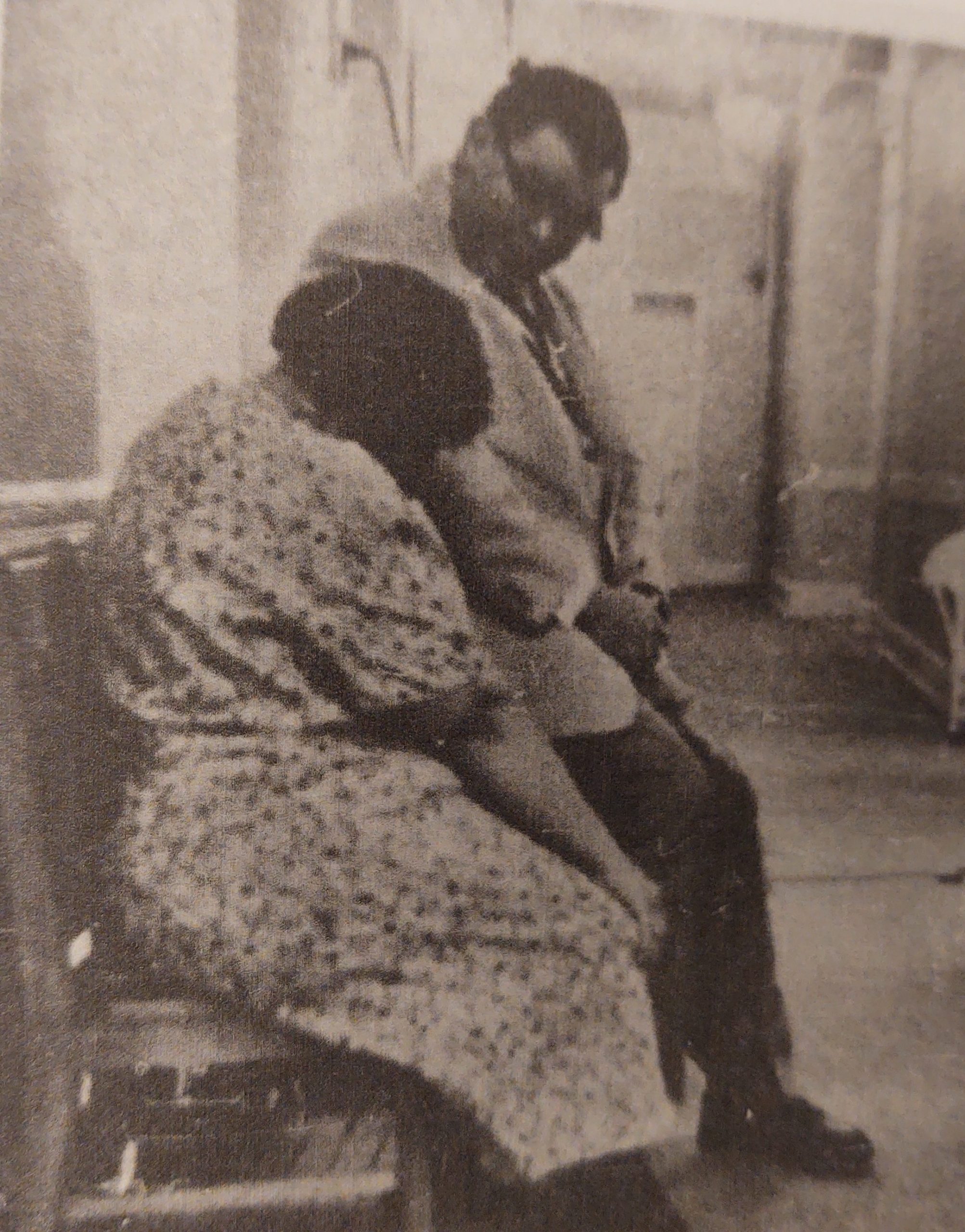
Photo Courtesy of “The Man Against Insanity.”
He started by treating patients with respect and using a combination of medications to neutralize the chemical occurrences of a patient’s brain. Rauwolfia worked as a tranquilizer. These pills from India would “cut down the output of kilowatts from the thalamus, which is the powerhouse of the brain. It was a kind of chemical lobotomy.”
The Traverse City State Hospital superintendents allowed Dr. Ferguson a lot of freedom to ‘develop’ experimental treatments. He started using medications on the most severely afflicted residents. This would enable him to observe behavior improvements more easily.
With 107 nurses helping to chart patients’ behaviors, he found the correct timing and dosages of Ritalin and Serpasil to regulate the most incurably insane.
One woman, Mrs. Gudrum, regularly disrobed and had been plagued with hallucinations for thirty years. Dr. Ferguson began a delicate dance of half a milligram of Serpasil three times a day along with intermittent doses of Ritalin. Within two weeks she was able to eat in the community dining room. She occasionally needed to be reminded to wear her shoes, otherwise she was appropriate. Later she earned ‘ground parole’ and enjoyed purchasing snacks at The Canteen (snack shop) on campus.
Thorazine was a powerful tranquilizer from France. Professor J.E. Stachlin reported that half of the inmates were able to leave the asylum with regular doses of “chlorpormazine.” (Thorazine) Dr. Ferguson’s desire was to help his patients rejoin their families and started prescribing Thorazine. Unfortunately, many families were not willing to welcome their relatives back into their homes.
The freedom Dr. Ferguson was given to experiment with medications was unusual and not appreciated by colleagues. They gossiped about his previous personal mental struggles and hospitalizations. However, Dr. Ferguson’s work has been a driving force in the development and uses of drugs to curb chemical imbalances. Sadly, he died when he was struck by a car as he was directing traffic around fire trucks outside the hospital in 1968.
Horrace Storrs worked at the institution for seven years and recalled Stellazine tranquilizer which brought patients ‘out’ and able to join others in the common room. He was impressed that these previously agitated people could now remember names of their peers and staff. Otherwise these patients were always aggressive and had to be segregated. “This made the patients easier to care for. ” Storrs stated in the oral history project recording.
Leo Garbier, who worked in Hall 6 in 1965, reported that females were steralized because they “kept getting knocked up on ‘ground parole,'” (Ground Parole was permission to walk around the hospital campus.) “One female patient was impregnated by a male patient on a screened porch. The girl’s mother took the child as her own.”

The ‘screen’ is actually welded metal forming a cage-like enclosure.
Art Nickerson, who worked at TCSH in the 1960’s reported that most patients were admitted involuntarily through the court system. The police would remove the handcuffs and it would take six to eight staff members to escort the new patient to the 30 day evaluation area.
With his sister’s suffering, John F. Kennedy, our 35th president, signed an amendment to the Social Security Act in 1963. “Maternal and Child Health and Mental Retardation Planning.” This was a predecessor to the 1990 legislation “American Association of People with Disabilities Act.” (IDEA)
Eunice Kennedy, Rose’s sister, founded Special Olympics in 1968. Eunice’s son, Anthony Shriver was also an activist for people with disabilities and founded “Best Buddies International.”

Treatments and legislation have improved the lives of people with disabilities and care for mentally challenged individuals. Many say that Rose Kennedy’s sad experiences have helped to shape a better future for those afflicted with disabilities.
In the 1960’s doses of LSD (lysergic acid diethylamide, a hallucinogenic drug) were being used to carefully guide patients into confronting their traumatic life experiences. There were many positive outcomes as patients were able to relax and face these demons that had haunted them. On October 24, 1968 LSD became an illegal substance. At this point these treatments went ‘underground.’
“It never fails to amaze me how much spontaneous insight people gain in an MDMA (Ecstacy) session. It would take ten weeks of normal psychotherapy to guide a person to the insights that the patient spontaneously come up with while on MDMA” an anonymous individual shared.
Dr. Prashanth Puspanathan, who goes by Dr. Prash, spoke of how people are beginning to become frustrated with the lack of access to these psychotherapy drugs. “We saw this with prohibition in the 1920s and the war on drugs in the current day.”
In 2018 Australian doctors began an underground psychedelic psychotherapy using drugs such as LSD, Psilocybin (Mushrooms) and MDMA (Ecstacy) with patients experiencing PTSD (Post Traumatic Stress Disorder), depression and cancer. At $150.00 an hour patients would seek out pre-treatment appointments. After several preplanning sessions about what to expect and putting plans in place, the psychedelic prescription would be administered. The doctor and an assistant guide the individual through the phases of the treatment.
“Neuroimaging shows the switching off of the “default mode network.” These are the thought patterns seen in depression. These scans show interconnected pathways opening new insights allowing a person to view one self from a new perspective.” “Cancer patients have an improved quality of life. “
Our daughter, Charlotte, being able to recover from epilepsy is a miracle. Dr. Chadehumbe worked tirelessly to unlock the mysteries of Charlotte’s brain. A child with epilepsy in the 1960’s would have been institutionalized. This has brought me to a new appreciation for the trials and treatments of mental conditions.
I am astounded about the evolution of treatments for the mentally ill. I revere the individuals, both doctors and patients, who sacrificed so much as they learned to navigate the brain and it’s functions. Now knowing that Rose Kennedy had a vital impact on the care and laws that are in place today was remarkable to me. Obviously, we still have unmarked pathways to explore within the human brain and the treatments to serve these individuals who suffer from mental afflictions.
Resources:
https://www.marieclaire.com/celebrity/a26261/secret-lobotomy-rosemary-kennedy/
“A Man Against Insanity” by Paul De Kruif 1957
“Beauty is Therapy” by Earle Steele and Kristen M. Hains 2001
“Admissions” by Jennifer Sowle 2010
“Traverse City State Hospital” by Chris Miller 2005
“Traverse City Oral History Project” by The Village of Grand Traverse Commons
https://www.abc.net.au/news/2018-08-30/underground-psychedelic-psychotherapy-mdma-lsd/10134044





